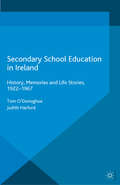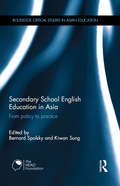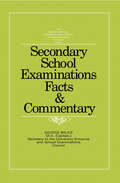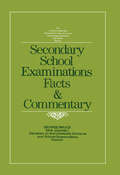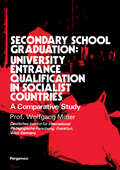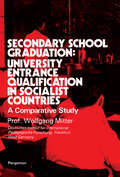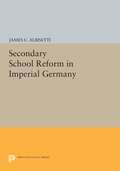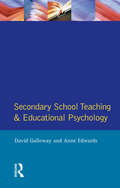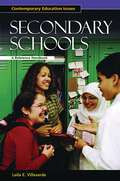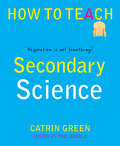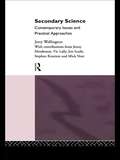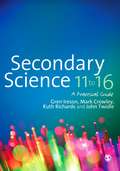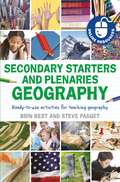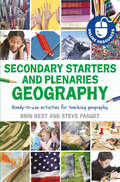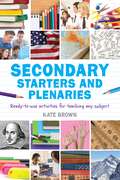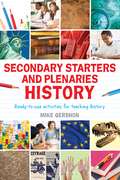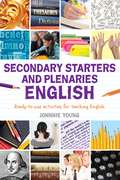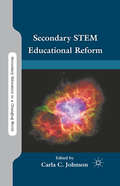- Table View
- List View
Secondary School Education in Ireland: History, Memories and Life Stories, 1922 - 1967 (Historical Studies in Education)
by Tom O'Donoghue Judith HarfordAdopting a life story approach, this book explores the memories of those who attended Irish secondary schools prior to 1967. It serves to initiate and enhance the practice of remembering secondary school education amongst those who attended secondary schools not just in Ireland, but around the world.
Secondary School English Education in Asia: From policy to practice (Routledge Critical Studies in Asian Education)
by Bernard Spolsky Kiwan SungContinuing on from the previously published Primary School English-Language Education in Asia: From Policy to Practice (Moon & Spolsky, 2012), this book compiles the proceedings which took place at the 2011 annual conference of AsiaTEFL which took place in Seoul, Korea. It surveys the current status, practices, challenges, and future directions of Secondary English education in 11 diverse countries - in Israel, Japan, Korea, Singapore, Bangladesh, India, Indonesia, Malaysia, Pakistan, Vietnam and China. Given the importance of secondary English education as the central feature for continuing development of target language and culture in English language teaching in Asia, each contributed chapter includes key policies, theories, and practices related to the development and implementation of country-specific curricular and instructional programs in secondary English educational contexts in these countries. Secondary School English Education in Asia: From Policy to Practice critically analyses both sides of the English language debate – from advantages to complications – in its chapters including: Educating for the 21st Century: The Singapore Experience Miles to Go …: Secondary Level English Language Education in India English Language Education Innovation for the Vietnamese Secondary School: The Project 2020 Exploring the Value of ELT as a Secondary School Subject in China: A Multi-goal Model for English Curriculum Secondary School English Education in Asia will appeal to English Language Teaching (ELT) researchers, teacher educators, trainee teachers and teachers, primarily those teaching in Asia.
Secondary School English Education in Asia: From policy to practice (Routledge Critical Studies in Asian Education)
by Bernard Spolsky Kiwan SungContinuing on from the previously published Primary School English-Language Education in Asia: From Policy to Practice (Moon & Spolsky, 2012), this book compiles the proceedings which took place at the 2011 annual conference of AsiaTEFL which took place in Seoul, Korea. It surveys the current status, practices, challenges, and future directions of Secondary English education in 11 diverse countries - in Israel, Japan, Korea, Singapore, Bangladesh, India, Indonesia, Malaysia, Pakistan, Vietnam and China. Given the importance of secondary English education as the central feature for continuing development of target language and culture in English language teaching in Asia, each contributed chapter includes key policies, theories, and practices related to the development and implementation of country-specific curricular and instructional programs in secondary English educational contexts in these countries. Secondary School English Education in Asia: From Policy to Practice critically analyses both sides of the English language debate – from advantages to complications – in its chapters including: Educating for the 21st Century: The Singapore Experience Miles to Go …: Secondary Level English Language Education in India English Language Education Innovation for the Vietnamese Secondary School: The Project 2020 Exploring the Value of ELT as a Secondary School Subject in China: A Multi-goal Model for English Curriculum Secondary School English Education in Asia will appeal to English Language Teaching (ELT) researchers, teacher educators, trainee teachers and teachers, primarily those teaching in Asia.
Secondary School Examinations: Facts and Commentary
by George J BruceThe title first covers the general concerns in secondary school examinations, such as the pass/fail concept, reforms, interpretation of results, and admissibility of subjects. Next, the selection tackles the examination in the ordinary level. The third chapter discusses the Certificate of Secondary Education (C.S.E.) examination; this chapter details the advantages of the C.S.E. along with its systems. Chapter 4 covers the advanced level and university entrance requirements. The next two chapters deal with the General Certificate of Education (G.C.E.) examining bodies. The seventh chapter examines the secondary school testing system in the U.S., while the last chapter talks about the future of the English secondary school examinations. The book will be of great use to both in-training and professional teachers. School administrators will also benefit from the text.
Secondary School Examinations: Facts and Commentary
by George J BruceSecondary School Examinations: Facts and Commentary presents the importance and development of the secondary school examinations. This book explains the pass/fail concept of the General Certificate Education (G.C.E.) wherein the candidates would be classified as either passing or failing with no sub-divisions within these two categories. Organized into eight chapters, this book begins with an overview of the underlying principles of the G.C.E. examination for teachers, students, and parents. This text then examines the development of Schools Council for Curriculum and Examinations, which signaled a fresh approach by the central authority to the problem of comparing standards by means of calibration tests. Other chapters consider the method of appointing small sub-committees to work on a syllabus whereby the subject advisory panels take care to guarantee a preponderance of teachers, not forgetting to ensure that boys' as well as girls' schools are represented. This book is a valuable resource for teachers, students, and parents.
Secondary School Graduation: A Comparative Study
by Wolfgang MitterSecondary School Graduation: University Entrance Qualification in Socialist Countries: A Comparative Study compares the qualifications of secondary school students for university entrance in five socialist states (Czechoslovakia, German Democratic Republic, Poland, Romania, and USSR). The importance of terminal awards to social and educational policy is emphasized. This book consists of five chapters and begins with an overview of the research project and its aims as well as the methodology used, followed by a discussion on the expansion of secondary education as a trend in industrial societies. The problem situation of secondary stage II education in relation to the terminal awards with higher education entrance qualification is highlighted. The following chapters explore similarities and differences in the socialist system of education; the structural characteristics of secondary level II; educational policy in the socialist countries; and the countries' desire to incorporate secondary stage II into compulsory schooling. This monograph will be of interest to educators and policymakers as well as students entering university.
Secondary School Graduation: A Comparative Study
by Wolfgang MitterSecondary School Graduation: University Entrance Qualification in Socialist Countries: A Comparative Study is a comparative study of the qualifications of secondary school students for university entrance in five socialist countries (Czechoslovakia, German Democratic Republic, Poland, Romania, and USSR). The importance of terminal awards to social and educational policy is emphasized. This monograph is comprised of five chapters and opens with an overview of the research project and its aims as well as the methodology used, followed by a discussion on the expansion of secondary education as a trend in industrial societies. The problem situation of secondary stage II education in relation to the terminal awards with higher education entrance qualification is also considered. The following chapters explore similarities and differences in the socialist system of education; the structural characteristics of secondary level II; educational policy in the socialist states; and the desire to incorporate secondary stage II into the sphere of compulsory schooling in all five countries. This text will appeal to educators and policymakers as well as students entering university.
Secondary School Reform in Imperial Germany
by James C. AlbisettiJames C. Albisetti explores the wide-ranging debate in Imperial Germany over the reform of secondary education to meet the new demands posed by unification, industrialization, and urbanization.Originally published in 1983.The Princeton Legacy Library uses the latest print-on-demand technology to again make available previously out-of-print books from the distinguished backlist of Princeton University Press. These editions preserve the original texts of these important books while presenting them in durable paperback and hardcover editions. The goal of the Princeton Legacy Library is to vastly increase access to the rich scholarly heritage found in the thousands of books published by Princeton University Press since its founding in 1905.
Secondary School Teaching and Educational Psychology
by David Galloway Anne EdwardsA companion volume to Primary School Teaching and Educational Psychology, this book concerns itself with the day-to-day business of teaching in a secondary school. Throughout the book four themes reoccur: that teachers can best understand the development of children by observing their learning and their relationships within school; that assessment and evaluation are integral to effective teaching; that effective teaching and learning depend on both teacher and child being able to monitor own progress and to find solutions to problems that occur; and finally that there must be explicit recognition of the common-ground between educational psychology and other disciplines such as sociology, philosophy and the history of education.
Secondary School Teaching and Educational Psychology
by David Galloway Anne EdwardsA companion volume to Primary School Teaching and Educational Psychology, this book concerns itself with the day-to-day business of teaching in a secondary school. Throughout the book four themes reoccur: that teachers can best understand the development of children by observing their learning and their relationships within school; that assessment and evaluation are integral to effective teaching; that effective teaching and learning depend on both teacher and child being able to monitor own progress and to find solutions to problems that occur; and finally that there must be explicit recognition of the common-ground between educational psychology and other disciplines such as sociology, philosophy and the history of education.
Secondary Schools: A Reference Handbook (Contemporary Education Issues)
by Leila VillaverdeA broad survey of secondary schools, their historical origins, and present-day goals, intentions, and practices in educating adolescents.Secondary Schools: A Reference Handbook charts the planning, designing, and administration of the various types of secondary schools in the U.S. and their goals. It maps the historical foundation of the school system, examines important social and cultural movements in education, analyzes legislation and policy issues, looks at standardization, and discusses reform.Always keeping the needs of students in close focus, this book examines public and private institutions, vocational curricula, schools within schools, as well as target audiences for specific institutions, educational standards, accessibility, admission policies, student assistance, and other important subjects.
Secondary Science: Respiration Is Not Breathing! (How to Teach)
by Catrin GreenSo, you have passion for your subject and you get to work with some of the funniest, most surprising and exceptional students. But teaching science isn’t always a walk in the park. How do you get students to think scientifically, remember all of those key words and not get acid in their eyes? Secondary Science is chockfull of workable ideas for the secondary science classroom. Ditch the stereotypical view of a science teacher: white coat, slides, teaching the limewater test to the same class for the fifth year in a row, and discover new and creative ways to inspire the next generation to use science.Areas covered include: the big ideas in science, scientific skills and knowledge, curriculum, practical work, difficult topics, differentiation, assessment, feedback and the science of memory and learning, including the spacing effect and interleaving.The book is packed with: advice about teacher talk, fun science games, ideas for developing scientific literacy, ideas for embedding mathematical skill in science, advice for extended writing in science, advice to make practical work safe, meaningful and worthwhile, and top tips for teaching the difficult topics that students tend to dislike! Catrin offers tips for teaching areas of the science curriculum including electricity, evolution and balancing equations.Suitable for all teachers, including NQTs and experienced teachers who are looking for new ideas. If you are looking for quick and easy ideas to make science fun and relevant, while ensuring that all students are successful and confident in your lessons, and not overloaded with facts, then this book is for you.
Secondary Science: Contemporary Issues and Practical Approaches
by Jerry WellingtonScience education has changed radically in recent years, both as a result of debates within the subject and because of curriculum legislation. Jerry Wellington discusses the major issues in science education today - such questions as the balance of content and process in the curriculum, the role of practical work and the nature of science as a subject - and uses this discussion to support a very practical resource for teachers in training and their mentors. The book covers every aspect of science teaching, including: Planning Differentiation and special needs Assessment Practical work Problem solving and investigations IT in science Handling sensitive issues, e.g. sex education Building on children's prior learning Throughout, Wellington's guidance is accompanied by suggestions for discussion, activities for individual and group use and annotated lists of further reaing aimed at helping the reader to build up a personal approach to the teaching of the subject. Students will also be helped by the glossaries of specialist terminology at the end of each chapter and by the references to National Curriculum attainment targets at every point in the book.
Secondary Science: Contemporary Issues and Practical Approaches
by Jerry WellingtonScience education has changed radically in recent years, both as a result of debates within the subject and because of curriculum legislation. Jerry Wellington discusses the major issues in science education today - such questions as the balance of content and process in the curriculum, the role of practical work and the nature of science as a subject - and uses this discussion to support a very practical resource for teachers in training and their mentors. The book covers every aspect of science teaching, including: Planning Differentiation and special needs Assessment Practical work Problem solving and investigations IT in science Handling sensitive issues, e.g. sex education Building on children's prior learning Throughout, Wellington's guidance is accompanied by suggestions for discussion, activities for individual and group use and annotated lists of further reaing aimed at helping the reader to build up a personal approach to the teaching of the subject. Students will also be helped by the glossaries of specialist terminology at the end of each chapter and by the references to National Curriculum attainment targets at every point in the book.
Secondary Science 11 to 16: A Practical Guide (PDF)
by Mark Crowley Dr Ruth L. Richards Mr John Twidle Ms Gren IresonAre you looking for teaching ideas to make your science lessons come alive? Full of suggestions for exciting practical work to engage children, this book addresses and explains the science behind the experiments, and emphasises the need to engage the learner through minds-on activities. It shows you where to make links to the national curricula in England, Scotland, Wales and Northern Ireland, and it covers the three sciences: chemistry, biology and physics. The detailed subject knowledge helps you grasp key concepts, and there are lots of useful diagrams to illustrate important points. Experiments include: - extracting DNA from a kiwi fruit - capturing rainbows - the chromatography of sweets - removing iron from cornflakes - a plate tectonic jigsaw These practical activities will provide you with ways to ensure your students respond enthusiastically to science, and the book will also help you develop your subject knowledge and ensure you meet your Qualified Teacher Status (QTS) standards. Perfect reading for Secondary Science PGCE students, as well as those on the Graduate Teacher Programme (GTP), this book is also ideal for non-specialists who are looking for support as they get to grips with the sciences. Gren Ireson is Professor of Science Education at Nottingham Trent University. Mark Crowley is a Teaching Research Fellow in the Centre for Effective Learning in Science, Nottingham Trent University. Ruth Richards is Subject Strand Leader for the PGCE and Subject Knowledge Enhancement (SKE) courses in Science at Nottingham Trent University, and an examiner for A-level Geology. John Twidle is Subject Leader for the PGCE and MSc Science programmes at Loughborough University.
Secondary Science 11 to 16: A Practical Guide
by Dr Ruth L. Richards Mark Crowley Mr John Twidle Ms Gren IresonAre you looking for teaching ideas to make your science lessons come alive? Full of suggestions for exciting practical work to engage children, this book addresses and explains the science behind the experiments, and emphasises the need to engage the learner through minds-on activities. It shows you where to make links to the national curricula in England, Scotland, Wales and Northern Ireland, and it covers the three sciences: chemistry, biology and physics. The detailed subject knowledge helps you grasp key concepts, and there are lots of useful diagrams to illustrate important points. Experiments include: - extracting DNA from a kiwi fruit - capturing rainbows - the chromatography of sweets - removing iron from cornflakes - a plate tectonic jigsaw These practical activities will provide you with ways to ensure your students respond enthusiastically to science, and the book will also help you develop your subject knowledge and ensure you meet your Qualified Teacher Status (QTS) standards. Perfect reading for Secondary Science PGCE students, as well as those on the Graduate Teacher Programme (GTP), this book is also ideal for non-specialists who are looking for support as they get to grips with the sciences. Gren Ireson is Professor of Science Education at Nottingham Trent University. Mark Crowley is a Teaching Research Fellow in the Centre for Effective Learning in Science, Nottingham Trent University. Ruth Richards is Subject Strand Leader for the PGCE and Subject Knowledge Enhancement (SKE) courses in Science at Nottingham Trent University, and an examiner for A-level Geology. John Twidle is Subject Leader for the PGCE and MSc Science programmes at Loughborough University.
Secondary Starters and Plenaries: Ready-to-use activities for teaching geography (Classroom Starters and Plenaries)
by Brin Best Steve PadgetThis book provides geography teachers with 50 cohesive suggestions for embedding and extending learning in the classroom: from individual to whole-class activities, and from the energetic to the sedate. Even better, every starter and plenary is easily-adaptable for the whole ability range of your class and ideas for extension and development keep each activity fresh. There are also PowerPoints, task sheets and other time-saving resources online. The book covers the whole spectrum of topics that every geography teacher needs to cover. Some ideas involve students managing and monitoring each other; others involve creative thinking and where practical and appropriate, the content is embedded in the real world so that students can immediately see the wider application of their efforts. In the 'teacher's tips' section, the author offers guidance on how to deliver the idea to get the best results based on years of trial and error.
Secondary Starters and Plenaries: Ready-to-use activities for teaching geography (Classroom Starters and Plenaries)
by Brin Best Steve PadgetThis book provides geography teachers with 50 cohesive suggestions for embedding and extending learning in the classroom: from individual to whole-class activities, and from the energetic to the sedate. Even better, every starter and plenary is easily-adaptable for the whole ability range of your class and ideas for extension and development keep each activity fresh. There are also PowerPoints, task sheets and other time-saving resources online. The book covers the whole spectrum of topics that every geography teacher needs to cover. Some ideas involve students managing and monitoring each other; others involve creative thinking and where practical and appropriate, the content is embedded in the real world so that students can immediately see the wider application of their efforts. In the 'teacher's tips' section, the author offers guidance on how to deliver the idea to get the best results based on years of trial and error.
Secondary Starters and Plenaries: Ready-to-use activities for teaching any subject
by Kate BrownStarters and plenaries are now established elements of all good lesson planning. A good starter gets a class engaged right from the word go, challenges and motivates students, and sets a positive tone fro the rest of the lesson. A good plenary allows students to focus on the key objectives of the lesson, and to reflect on the progress they have made.
Secondary Starters and Plenaries: Ready-to-use activities for teaching any subject
by Kate BrownStarters and plenaries are now established elements of all good lesson planning. A good starter gets a class engaged right from the word go, challenges and motivates students, and sets a positive tone fro the rest of the lesson. A good plenary allows students to focus on the key objectives of the lesson, and to reflect on the progress they have made.
Secondary Starters and Plenaries: Ready-to-use activities for teaching history (Classroom Starters and Plenaries)
by Mike GershonLooking for time saving, creative, ready-to-use activities to kick-start and round up your history lessons? Look no further!Starters and plenaries are now an essential part of all lessons and this highly practical book provides busy History teachers with creative activities to use in the classroom. The starter ideas will ensure the first five minutes of any secondary History lesson are a time for motivation, energy and forward thinking, and the plenaries will help students to reflect on and embed their learning at the endStep-by-step instructions, teacher's tips and topic-specific examples make these 25 starters and 25 plenaries easy to adapt for any History lesson, whether you are teaching World War Two, Henry VII or Ancient Egypt. The activities will help students to develop their skills in assessment and interpretation of sources and evidence, as well as reasoning, enquiry and comparison. This versatile book is also accompanied by online resources providing everything you need not just for planning starters and plenaries, but also delivering them to your class.
Secondary Starters and Plenaries: Ready-to-use activities for teaching history (Classroom Starters and Plenaries)
by Mike GershonLooking for time saving, creative, ready-to-use activities to kick-start and round up your history lessons? Look no further!Starters and plenaries are now an essential part of all lessons and this highly practical book provides busy History teachers with creative activities to use in the classroom. The starter ideas will ensure the first five minutes of any secondary History lesson are a time for motivation, energy and forward thinking, and the plenaries will help students to reflect on and embed their learning at the endStep-by-step instructions, teacher's tips and topic-specific examples make these 25 starters and 25 plenaries easy to adapt for any History lesson, whether you are teaching World War Two, Henry VII or Ancient Egypt. The activities will help students to develop their skills in assessment and interpretation of sources and evidence, as well as reasoning, enquiry and comparison. This versatile book is also accompanied by online resources providing everything you need not just for planning starters and plenaries, but also delivering them to your class.
Secondary Starters and Plenaries: Creative activities, ready-to-use for teaching English (Classroom Starters and Plenaries)
by Johnnie YoungThis book provides English teachers with 50 cohesive suggestions for embedding and extending learning in the classroom: from individual to whole-class activities, and from the energetic to the sedate, all with realistic timings for each. Even better, every starter and plenary contains an 'ideas generator', making it easily-adaptable for the whole ability range of your class and keeping it fresh for you to use, and there are PowerPoints, task sheets and other time-saving resources online. The book covers the whole spectrum of topics that every English teacher needs to cover, and makes use of music, drama, maps, charts and practical props. Some ideas involve students managing and monitoring each other; some use all the senses; others involve creative thinking and where practical and appropriate, the content is embedded in the real world so that students can immediately see the wider application of their efforts. The 'teacher tips' section offers guidance on how to deliver the idea to get the best results based on years of trial and error by the author.
Secondary Starters and Plenaries: Creative activities, ready-to-use for teaching English (Classroom Starters and Plenaries)
by Johnnie YoungThis book provides English teachers with 50 cohesive suggestions for embedding and extending learning in the classroom: from individual to whole-class activities, and from the energetic to the sedate, all with realistic timings for each. Even better, every starter and plenary contains an 'ideas generator', making it easily-adaptable for the whole ability range of your class and keeping it fresh for you to use, and there are PowerPoints, task sheets and other time-saving resources online. The book covers the whole spectrum of topics that every English teacher needs to cover, and makes use of music, drama, maps, charts and practical props. Some ideas involve students managing and monitoring each other; some use all the senses; others involve creative thinking and where practical and appropriate, the content is embedded in the real world so that students can immediately see the wider application of their efforts. The 'teacher tips' section offers guidance on how to deliver the idea to get the best results based on years of trial and error by the author.
Secondary STEM Educational Reform (Secondary Education in a Changing World)
by Carla C. JohnsonFederal and state funding agencies have invested billions of dollars into secondary STEM (Science, Technology, Education, Mathematics) educational reform over the past decade. This volume addresses the interplay of external and internal variables associated with school reform and how this dynamic has impacted many efforts.
